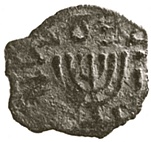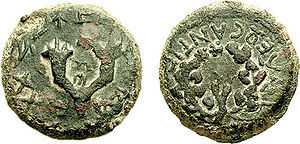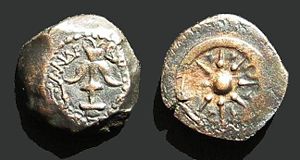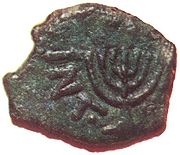
Hashmonean coinage
Encyclopedia


Aristobulus
Judah Aristobulus I , the first ruler of the Hebrew Hasmonean Dynasty to call himself "king," was the eldest of the five sons of John Hyrcanus, the previous leader. Josephus would declare him the first Jew in 481 years to “wear the diadem on his head”...
bowing before a camel with a palm branch in his hand.
The Hebrew inscriptions found on Hasmonean
Hasmonean
The Hasmonean dynasty , was the ruling dynasty of Judea and surrounding regions during classical antiquity. Between c. 140 and c. 116 BCE, the dynasty ruled semi-autonomously from the Seleucids in the region of Judea...
coins are:
- "Yehochanan Kohen Gadol Chever Hayehudim" (Yehochanan the High Priest, Council of the JewsJewsThe Jews , also known as the Jewish people, are a nation and ethnoreligious group originating in the Israelites or Hebrews of the Ancient Near East. The Jewish ethnicity, nationality, and religion are strongly interrelated, as Judaism is the traditional faith of the Jewish nation...
). - "Yehochanan Kohen Gadol Rosh Chever Hayehudim" (Yehochanan the High Priest, Head of the Council of the Jews).
- "Yehonatan Kohen Gadol Chever Hayehudim" (Yehonatan the High Priest, Council of the Jews).
- "Yehonatan Hamelech" (Yehonatan the King).
- "Yehudah Kohen Gadol Chever Hayehudim" (Yehudah the High Priest, Council of the Jews).
- "Malka Aleksandros" (King Alexander)
- "Matisyahu Kohen Gadol Chever Hayehudim" (Matisyahu the High Priest, Council of the Jews).
- "Matisyahu HaKohen" (Matisyahu the High Priest).
- "Mattityah"
The Hasmonean Kingdom and era (164 BCE – 35 BCE)
The Hashmonean kingdom lasted for 103 years. It was ruled by SimonSimon Maccabaeus
Simon Thassi was the second son of Mattathias and thus a member of the Hasmonean family. The name "Thassi" has an uncertain meaning...
the son of Matisyahu
Mattathias
Mattathias ben Johanan was a Jewish priest whose role in the Jewish revolt against the Syrian Greeks is related in the Books of the Maccabees...
; then his son Yochanan
John Hyrcanus
John Hyrcanus was a Hasmonean leader of the 2nd century BC.-Name:...
, then his son Yehuda Aristobolus
Aristobulus
Judah Aristobulus I , the first ruler of the Hebrew Hasmonean Dynasty to call himself "king," was the eldest of the five sons of John Hyrcanus, the previous leader. Josephus would declare him the first Jew in 481 years to “wear the diadem on his head”...
, then his wife Salome Alexandra
Salome Alexandra
Salome Alexandra or Alexandra of Jerusalem , was the only Jewish regnant queen, with the exception of her own husband's mother whom he had prevented from ruling as his dying father had wished, and of the much earlier usurper Athaliah...
, then his brother Alexander Yannai
Alexander Jannaeus
Alexander Jannaeus was king of Judea from 103 BC to 76 BC. The son of John Hyrcanus, he inherited the throne from his brother Aristobulus I, and appears to have married his brother's widow, Shlomtzion or "Shelomit", also known as Salome Alexandra, according to the Biblical law of Yibbum...
then his sons Hyrcanus
Hyrcanus II
Hyrcanus II, a member of the Hasmonean dynasty, was the Jewish High Priest and King of Judea in the 1st century BC.-Accession:Hyrcanus was the eldest son of Alexander Jannaeus, King and High Priest, and Alexandra Salome...
and Aristobulus
Aristobulus II
Aristobulus II was the Jewish High Priest and King of Judea, 66 BC to 63 BC, from the Hasmonean Dynasty.-Family:Aristobulus was the younger son of Alexander Jannaeus, King and High Priest, and Alexandra Salome. After the death of Alexander in 76 BC, his widow succeeded to the rule of Judea and...
. When the brothers Hyrcanus and Aristoblulus each asked for Rome to intervene on their behalf; as a result Judea fell under the greater rule of Rome as an autonomous province but still with a significant amount of independence. The last Hashmonean king was Aristobulus's son Matisyahu Antigonus
Antigonus the Hasmonean
Antigonus II Mattathias was the last Hasmonean king of Judea. He was the son of King Aristobulus II of Judea...
.
John Hyrcanus
John Hyrcanus (also known as Yochanan Hyrcanus) (reigned 134 BCE – 104 BCE, died 104 BCE). Minted prutot that said:- Yehochanan the Kohen GadolKohen GadolThe High Priest was the chief religious official of Israelite religion and of classical Judaism from the rise of the Israelite nation until the destruction of the Second Temple of Jerusalem...
and council of the Jews (SanhedrinSanhedrinThe Sanhedrin was an assembly of twenty-three judges appointed in every city in the Biblical Land of Israel.The Great Sanhedrin was the supreme court of ancient Israel made of 71 members...
) - Yehochanan the Kohen GadolKohen GadolThe High Priest was the chief religious official of Israelite religion and of classical Judaism from the rise of the Israelite nation until the destruction of the Second Temple of Jerusalem...
and the head of council of the Jews - Yehochanan the Kohen GadolKohen GadolThe High Priest was the chief religious official of Israelite religion and of classical Judaism from the rise of the Israelite nation until the destruction of the Second Temple of Jerusalem...
and the [council of] the Jews - 'A' (May have stood for Antiochus VII) Yehochanan the Kohen GadolKohen GadolThe High Priest was the chief religious official of Israelite religion and of classical Judaism from the rise of the Israelite nation until the destruction of the Second Temple of Jerusalem...
and council of the Jews
He also had monograms on some prutot on the cornucopia side, just left of the cornucopia, some resembling Ά, Π or Λ.
Alexander Jannaeus
Alexander Jannaeus (also known as Alexander Jannai/Yannai), king of JudeaJudea
Judea or Judæa was the name of the mountainous southern part of the historic Land of Israel from the 8th century BCE to the 2nd century CE, when Roman Judea was renamed Syria Palaestina following the Jewish Bar Kokhba revolt.-Etymology:The...
from (103 BCE to 76 BCE), son of John Hyrcanus
John Hyrcanus
John Hyrcanus was a Hasmonean leader of the 2nd century BC.-Name:...
, inherited the throne from his brother Aristobulus
Aristobulus
Judah Aristobulus I , the first ruler of the Hebrew Hasmonean Dynasty to call himself "king," was the eldest of the five sons of John Hyrcanus, the previous leader. Josephus would declare him the first Jew in 481 years to “wear the diadem on his head”...
, and married his brother's widow, Shlomtzion or "Shelomit" (see Coins of Alexander Jannaeus
Coins of Alexander Jannaeus
Alexander Jannaeus was a Hasmonean ruler, and also the third Hasmonean to mint coins, preceded by Hyrcanus I and Aristobulus. Jannaeus minted the largest and most broadest selection of Hasmonean Coinage.]-Types of Coinage:...
).

Matisyahu Antigonus
Antigonus the Hasmonean (also known as Matisyahu Antigonus) was the son of King Aristobulus IIAristobulus II
Aristobulus II was the Jewish High Priest and King of Judea, 66 BC to 63 BC, from the Hasmonean Dynasty.-Family:Aristobulus was the younger son of Alexander Jannaeus, King and High Priest, and Alexandra Salome. After the death of Alexander in 76 BC, his widow succeeded to the rule of Judea and...
of Judea
Judea
Judea or Judæa was the name of the mountainous southern part of the historic Land of Israel from the 8th century BCE to the 2nd century CE, when Roman Judea was renamed Syria Palaestina following the Jewish Bar Kokhba revolt.-Etymology:The...
.

Rev: Greek inscription; reading "BASILEWS ANTIGONOY" (King Antignus).
See also
- List of historical currencies
- List of artifacts significant to the Bible
- ZuzZuz (coin)A Zuz was an ancient Hebrew silver coin struck during the Bar Kochba revolt. They were overstruck on Roman Imperial denarii or Roman provincial drachmas of Vespasian, Titus, Domitian, Trajan and Hadrian...
- ShekelShekelShekel , is any of several ancient units of weight or of currency. The first usage is from Mesopotamia around 3000 BC. Initially, it may have referred to a weight of barley...
- HasmoneanHasmoneanThe Hasmonean dynasty , was the ruling dynasty of Judea and surrounding regions during classical antiquity. Between c. 140 and c. 116 BCE, the dynasty ruled semi-autonomously from the Seleucids in the region of Judea...
- MaccabeesMaccabeesThe Maccabees were a Jewish rebel army who took control of Judea, which had been a client state of the Seleucid Empire. They founded the Hasmonean dynasty, which ruled from 164 BCE to 63 BCE, reasserting the Jewish religion, expanding the boundaries of the Land of Israel and reducing the influence...
- Maccabean Revolt
- Judah Maccabeus
- Jonathan MaccabaeusJonathan MaccabaeusJonathan Apphus was leader of the Hasmonean Dynasty of Judea from 161 to 143 BCE. The name Apphus could mean = "the dissembler", "the Wary", or "the diplomat", in allusion to a trait prominent in him -Leader of the Jews:...
- Simon Maccabeus
- MattathiasMattathiasMattathias ben Johanan was a Jewish priest whose role in the Jewish revolt against the Syrian Greeks is related in the Books of the Maccabees...
- Alexander JannaeusAlexander JannaeusAlexander Jannaeus was king of Judea from 103 BC to 76 BC. The son of John Hyrcanus, he inherited the throne from his brother Aristobulus I, and appears to have married his brother's widow, Shlomtzion or "Shelomit", also known as Salome Alexandra, according to the Biblical law of Yibbum...
- John HyrcanusJohn HyrcanusJohn Hyrcanus was a Hasmonean leader of the 2nd century BC.-Name:...
- AristobulusAristobulusJudah Aristobulus I , the first ruler of the Hebrew Hasmonean Dynasty to call himself "king," was the eldest of the five sons of John Hyrcanus, the previous leader. Josephus would declare him the first Jew in 481 years to “wear the diadem on his head”...
- Salome AlexandraSalome AlexandraSalome Alexandra or Alexandra of Jerusalem , was the only Jewish regnant queen, with the exception of her own husband's mother whom he had prevented from ruling as his dying father had wished, and of the much earlier usurper Athaliah...
- Hyrcanus IIHyrcanus IIHyrcanus II, a member of the Hasmonean dynasty, was the Jewish High Priest and King of Judea in the 1st century BC.-Accession:Hyrcanus was the eldest son of Alexander Jannaeus, King and High Priest, and Alexandra Salome...
- Aristobulus IIAristobulus IIAristobulus II was the Jewish High Priest and King of Judea, 66 BC to 63 BC, from the Hasmonean Dynasty.-Family:Aristobulus was the younger son of Alexander Jannaeus, King and High Priest, and Alexandra Salome. After the death of Alexander in 76 BC, his widow succeeded to the rule of Judea and...
External Links
- List of all Ancient Hebrew and Aramaic words from Jewish coins and their meanings.. (Judaea Coin ArchiveJudaea Coin ArchiveThe Judean Coin archives , is an online photo gallery archive of photos and information about ancient Jewish coinage, located at . The archive also has the only online search of Jewish coins on the web, with Proto-Hebrew letters...
)

